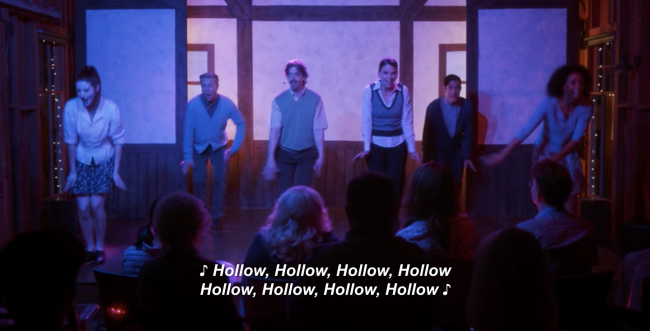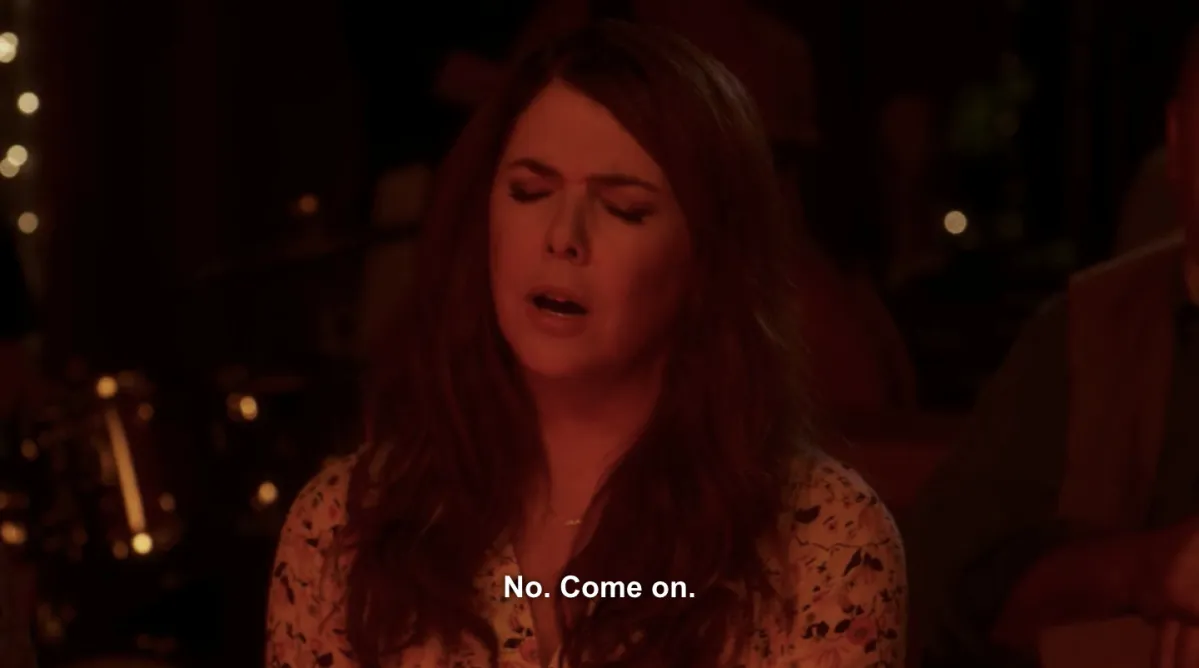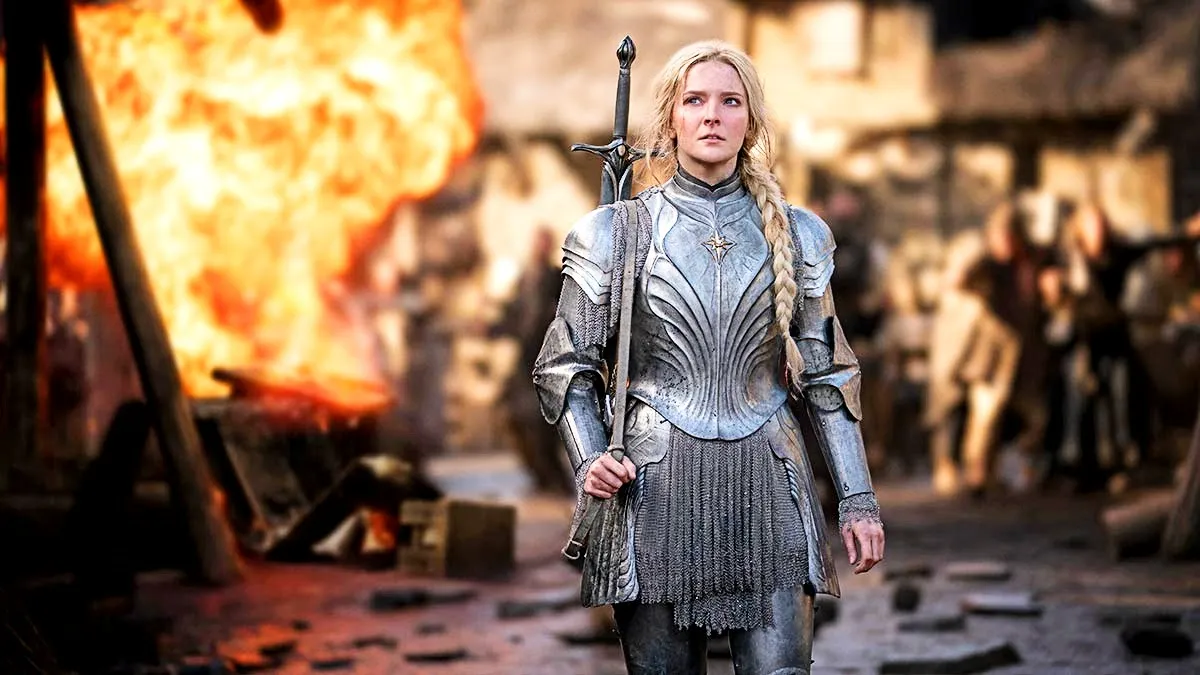This past weekend, Netflix hosted the Gilmore Girls revival, featuring the triumphant return of co-creators Amy Sherman-Palladino and Daniel Palladino, who finally got the chance to tell the ending of the story that they intended to tell back in 2006. The wife-and-husband duo crafted six seasons of much-loved television together, but after a contract dispute, the seventh and final season of Gilmore Girls had to trundle on without them. The show did its best, but even in its strongest moments, season 7 feels more like a piece of fan-fiction than the real deal.
You’d think, then, that the revival would be a satisfying return to form for Gilmore Girls. In many ways, it is. The four-part series, which most die-hard fans probably watched in one go this past Thanksgiving weekend, features a lot of laughs and plenty of tearjerker moments, but it’s also got some very bizarre problems, mostly due to the fact that the show’s denouement would’ve made a lot more sense if everyone involved were … y’know … ten years younger. Roughly.
Gilmore Girls‘ return has also forced us all to face the larger question of whether the quaint world of Stars Hollow even looks familiar to us anymore, let alone comforting, in 2016. Lorelai and Rory were always self-involved anti-heroines, but their observational awareness tended to bounce off the surface of Stars Hollow’s unflappable charms. But, as written in 2016, their jaded attitudes—and the unfailing subservience of the small town that is inexplicably obsessed with them—comes across as a lot more bizarre, in the post-ironic world of 2016 media.
This tension is encapsulated in a bizarre ten-minute musical segment that occurs in episode three, an episode that has swiftly earned the reputation as the designated worst episode of the four-part series. It’s worth noting that while Amy Sherman-Palladino wrote the first and last episodes of the four-parter, Daniel Palladino wrote episodes two and three. Episode three in particular has all the hallmarks of a Daniel episode: the jokes told by the titular Girls tend to have a crueler knife-twist to them, and the plot machinations are relentlessly quirky—particularly the now-infamous Stars Hollow: The Musical.
Daniel Palladino has long been a fan of the “musical episode” on Gilmore Girls, or at least, of including a show-within-a-show as a narrative device. In season three, episode 14, he wrote Miss Patty’s one-woman extravaganza, directed by Kirk (of course) and titled, “Buckle Up, I’m Patty.” In season 5, episode 18, we got to see a production helmed by Taylor—a museum about Stars Hollow’s oft-retconned past, acted out by mannequins rather than people. In the show’s sixth season, in episode 5, we watched Lorelai attend one of Miss Patty’s dance students’ recitals. Our heroine voiced her mocking discomfort with musical theatre even back then, as children danced around her singing “Magic to Do” from Pippin and throwing confetti in her face. These are all Daniel Palladino episodes, and his love-hate relationship with the theatre is palpable in each of them—particularly with the idea of embarrassingly genuine community theatre projects.
It’s not as though Amy Sherman-Palladino doesn’t share the sentiment, though, at least on some level. The pair of them co-wrote a season five episode about a Stars Hollow war reenactment, which also has some similarities in structure to these other stories. It provides an opportunity for Lorelai to play the canny observer, the audience stand-in who points and laughs at the earnestness of these small-town actors, but that mockery is usually done with a sense of love and a sense of inclusion. Lorelai may mock Stars Hollow, but it’s also a place that welcomed her without question, no matter how many snarky asides she makes.
Again, Stars Hollow itself represents a pre-irony, early 2000s level of earnestness that seems even more bizarre to watch now, and it also feels uniquely unrealistic and theatrical, even by 2000s television standards. Sometimes extras play more than one role of the same name, and the sets of Gilmore Girls never looked entirely real; it always felt like a studio backlot, with every location around the corner from every other location. Emily Gilmore supposedly lives in Hartford, and Rory eventually ends up at Yale in New Haven; somehow, even though those two locations are an hour away in real life (or longer, depending on traffic), on the show, they’re all “about thirty minutes away” (usually less), and the fictional town of Stars Hollow is always in the center of it all. In other words, it’s always felt like a set for a play rather than a set for a TV show. Stars Hollow has always had markers of the surreal.
By adding in the plays within a play, and putting the affable background townspeople of Stars Hollow into the roles, we are invited to laugh both at and with the absurdity that is Stars Hollow. But … that sense of familiarity is gone from Stars Hollow: The Musical, since the stars of this musical aren’t from Stars Hollow at all. This is not an independent film made by Kirk, nor a song sung by Miss Patty and Babette. This is a musical starring people we don’t recognize at all—cameos by real-life musical theatre blockbusters.
Specifically, the musical stars musical theatre heavy-hitter Sutton Foster as an actress who plays multiple roles—a woman who represents every woman in Stars Hollow, throughout the ages. A woman around whom the entire town revolves. Christian Borle co-stars in the musical as an endlessly-changing love interest and/or narrative device; he is also a famous musical theatre actor in his own right, who used to be married to Sutton Foster, and apparently, the two of them used to watch Gilmore Girls together. I mean, I know Gilmore Girls loves obscure references, but the meta-text here is buried pretty deep, even by Palladino standards.
Allow me to explain the joke: Sutton Foster’s character serves as a clear stand-in for Lorelai herself. After all, Foster starred in Amy Sherman-Palladino’s Bunheads, another TV show that deserved a more conclusive ending and never got one. Bunheads was also about a strained maternal relationship, featuring Kelly Bishop not as Emily Gilmore but as Fanny Flowers, the mother-in-law to Sutton Foster’s character. The dynamic was different in some ways, but the parallels to Gilmore Girls could not be denied, even at the time. Fans tend to view Bunheads as a spiritual successor, with some rejecting the show as not quite right. It’s a similar story, but with just enough elements changed to feel out-of-body and surreal. (Sort of like a certain ten-minute musical I might mention.)
In the context of Stars Hollow: The Musical, then, it makes sense that Sutton Foster would play the woman around whom the town revolves: the Lorelai Gilmore, if you will. It also makes sense that Lorelai, and the Netflix viewers, would find the experience of watching this musical to be bizarre and jarring rather than entertaining. As Sutton Foster sings her heart out and endures a painfully unfunny Hamilton tribute, Lorelai cringes in the darkness of the theatre. She gets shushed whenever she tries to crack one-liners; she ends up sitting in silence, taking notes on her notepad and grimacing at the embarrassment of this show.
Insofar as I can glean any sort of message from Stars Hollow: The Musical, it seems to be: don’t try to romanticize the past. The show’s opening scene, which Taylor wrote in tribute to the plays of Edward Albee (e.g., Who’s Afraid of Virginia Woolf?), culminates with this haunting quote: “I wish I was in the past. It’s better than any future with you!” The rest of the show does indeed take place in the past; the next song features settlers building Stars Hollow, which apparently requires them to dig up a river and move it (?!). The following song, set in a “revolutionary time,” includes a joke about getting married to your relatives, plus lines like this: “We’ll have 14 kids, and hope that three will survive.”
All of these unnerving lines are juxtaposed with Lorelai’s horrified facial expression, and the joyful pleased expressions of everyone else watching the show. Next up, we’ve got the Industrial Revolution and the worst rapping you’ve ever heard (the Hamilton parody). Then, the show skips ahead to the present day, where Sutton Foster sings to us that “the world is a terrible place,” and then she and Christian Borle list off a series of small inconveniences, like “tiny airplane seats” and “what restaurants charge for wine.” The worst thing they can come up with? “Putin.” But don’t worry: Stars Hollow is immune to all of those scary external problems, or so this song seems to promise, as the actors repeat “hollow” in haunting harmonies. “What’s there not to love about the town of Stars Hollow?”
Then, who could forget the musical’s final song, which is just a cover of ABBA’s “Waterloo”? “The history book on the shelf / is always repeating itself … Waterloo, couldn’t escape if I wanted to.”

After the excruciating ten minutes end, Lorelai listens as the rest of the town lavishes praise upon Taylor’s musical. She is the sole voice of dissent, pointing out that they shouldn’t be ripping off Hamilton (Taylor argues that it’s more of an homage). She also says, in passing, that the leading lady sure does seem to have a revolving door of dudes. (As for whether that’s intended to be a commentary on Lorelai and Rory’s own boyfriends … well, it’s hard to say, but this show has never been entirely kind to its own heroines on that score.) Stars Hollow: The Musical is, nominally, a reflection of what Taylor believes is important about the town, but Lorelai can’t seem to get past the fact that it’s not right. Or perhaps the problem is that the musical doesn’t really matter. It’s just a show, right?
And so is Gilmore Girls, obviously. If this recreation of Stars Hollow doesn’t feel quite right, well, perhaps that’s because it isn’t. It’s not just surreal, it’s actively absurd—one might even go so far as to call it The Theatre of the Absurd. This isn’t Edward Albee so much as Samuel Beckett and Eugène Ionesco. Like an absurdist play, Stars Hollow: The Musical repeats mundane facts over and over until they become meaningless; its self-referential attitude is simultaneously boring and jarring. It’s actively hard to pay attention to it.
But the world of Stars Hollow in 2016 is absurd. It’s Waiting for Godot levels of absurd. It’s absurd that the entirety of Stars Hollow seems to have been encased in a jello mold for the past ten years. Why didn’t Lorelai and Luke get married before now, or discuss children? Because there were no Palladinos to write the dialogue for them. Why didn’t Rory write a book before now? Why did her entire career flounder? Why is she still entranced with the same boys that she met ten years ago, with seemingly no change at all? Why is everything exactly the same? Is that comforting, or is it alienating?
I’m not sure. I think it might be both. At the end of episode three, when Rory tells her mother that she’s planning to write a book about their life together, we already know what it will be called. We know the title long before we see Rory type it out. Lorelai reacts with horror at the idea of having to read her own story back again—at having to see herself on stage, on screen, on the page. But, as Rory points out, it’s not just Lorelai’s story—it’s Rory’s story. They both have the same story, and as the revival’s finale shows us with its last four words, that cyclical fate is apparently inescapable.
But, as the musical says, what’s there not to love about the town of Stars Hollow?
(images via Netflix screencaps)
Want more stories like this? Become a subscriber and support the site!
—The Mary Sue has a strict comment policy that forbids, but is not limited to, personal insults toward anyone, hate speech, and trolling.—
Follow The Mary Sue on Twitter, Facebook, Tumblr, Pinterest, & Google+.









Published: Nov 29, 2016 11:37 am